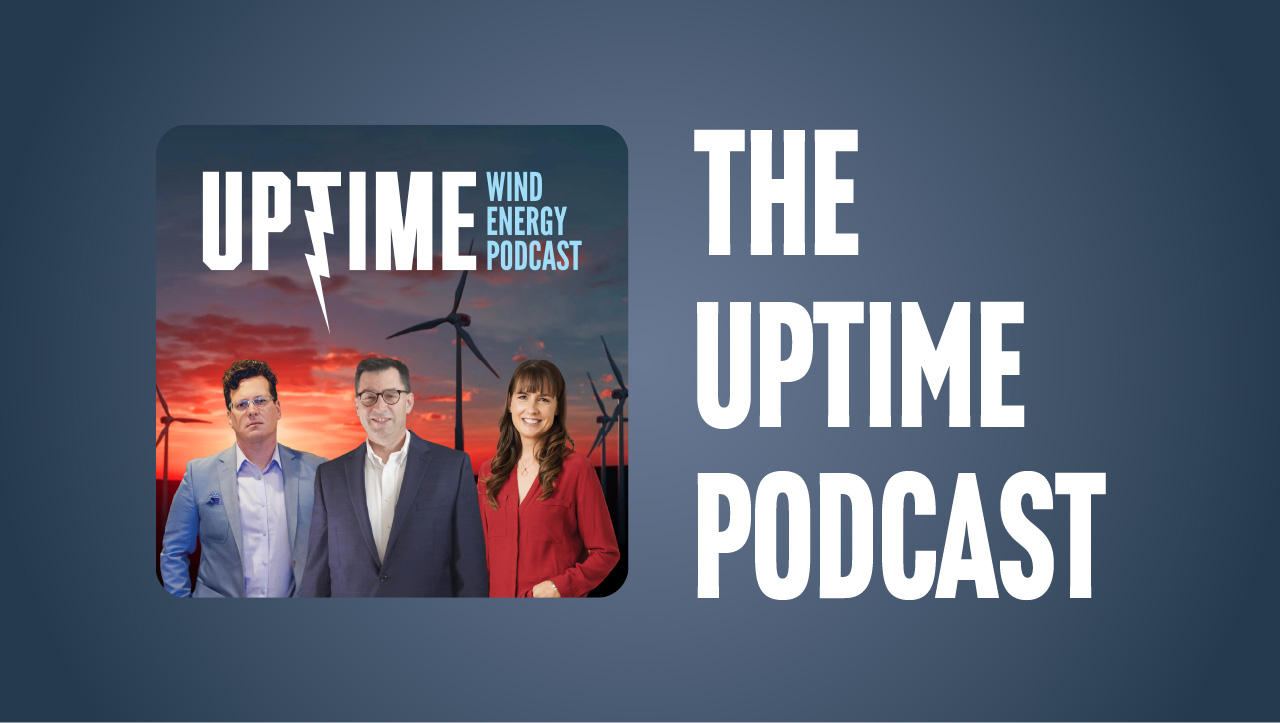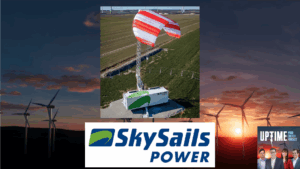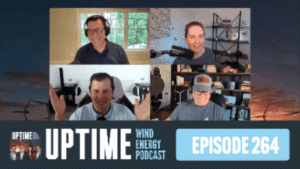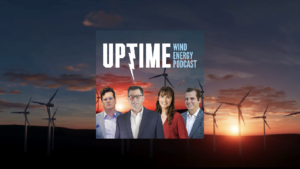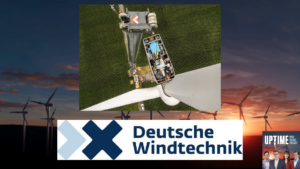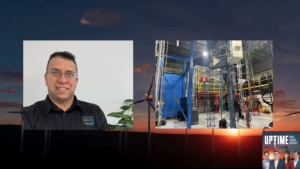Rosie Barnes is the CEO and Founder of Pardalote Consulting which is based in Canberra, Australia. Rosie holds a PhD in composite material structures and worked in blade design engineering at LM Wind Power focusing on blade de-icing systems. Rosie is known internationally for her Engineering with Rosie YouTube channel and co-hosting the Uptime Wind Energy Podcast.
Pardalote Consulting – https://www.pardaloteconsulting.com
Weather Guard Lightning Tech – www.weatherguardwind.com
Intelstor – https://www.intelstor.com
Podcast: Play in new window | Download
Sign up now for Uptime Tech News, our weekly email update on all things wind technology. This episode is sponsored by Weather Guard Lightning Tech. Learn more about Weather Guard’s StrikeTape Wind Turbine LPS retrofit. Follow the show on Facebook, YouTube, Twitter, Linkedin and visit Weather Guard on the web. And subscribe to Rosemary Barnes’ YouTube channel here. Have a question we can answer on the show? Email us!
Pardalote Interview
Allen Hall: I am Allen Hall, host of the Uptime Wind Energy Podcast. Our guest today is Rosemary Barnes, founder and CEO of Pardalote Consulting. Pardalote is based in Canberra, Australia, and as we well know, Australia is a leader in renewable energy. Pardalote Consulting provides consulting services to wind developers, asset owners, and inventors, and Pardalote specializes in technical due diligence, technical.
Assessments and patent evaluation. They have a deep understanding of the clean energy industry and are able to provide clients with accurate and unbiased information. Rosemary is also creative force and host of the widely popular. YouTube Channel Engineering with Rosie, and she is co-host of the world famous Uptime Wind Energy podcast. Rosemary, welcome to the program.
Rosie Barnes: Thank you. What a great intro. Your best. Your best ever.
Allen Hall: Well, Rosemary, we wanted to have you on the podcast because we’ve never highlighted your consulting business, which is extremely popular in Australia and around the world because you are one of the world’s blade experts.
You want to describe what Pardalote does, and I’ll give a little intro there, but you can describe a little bit better than I can.
Rosie Barnes: So we work with all kinds of energy transition technologies, not just wind. But I guess today we might as well focus on the, the wind energy part, all aspects of the technology development lifecycle.
So that goes right from. Conceptual design all the way through to implementation and claims assessments.
Allen Hall: So, Rosemary, your background is in structural engineering, most particularly composite engineering for blades.
Rosie Barnes: I did all of my degrees in Australia. I did one year of my undergraduate degree in the US at uc Davis.
I, at the time, I had this idea I wanted to be an aerospace engineer. And UC Davis is a really good a school. So I went there and completed all of the core aerospace subjects in one year which was just a, a lot to do all at once, but also really fun. And I learned in the process that I didn’t really want to be an aerospace engineer.
I. Mostly ’cause I, I’m not so driven to work in defense, which is where most of the money is, but I am lucky enough that coincidentally all of the same science and, you know, analysis that you use for airplanes and spacecraft is very closely related to wind energy. So I went back to university and did a PhD, a structural design project on Yeah.
Composite material structures specifically related to wind turbines. It was, yeah. Or new, new ways to design wind turbine blades and other complex composite structures. And then I handed that thesis in one day, and literally the next day I was on a plane to Denmark to go meet the team of a company. I had a job offer with.
And yeah, I ended up accepting that and, and living in Denmark for five years.
Allen Hall: And you were working with LM Wind Power, which obviously is a huge company in terms of blade production and has some of the most advanced blades on the planet. So you got to be in the factory for a number of years and that’s, I, I consider that to be a huge advantage if you’re an engineer because you can understand how the blades are made and designed.
So when. You see problems out in the field, you can get a basic understanding of probably what happened.
Rosie Barnes: Yeah, exactly. It’s it, it’s incredibly hard work to work in a factory and I have always massively respected those engineers that work full-time in a factory. ’cause you know, I would go for a month, two months, three months maybe when I was taking a new product into prototyping or into serial production.
But the schedules are intense. ’cause, you know, those factories are like a finely tuned machine to push blades out. You know, usually every 24 hours on the dot, you know, one, one comes, one comes off. And so it’s almost like. Choreographed like a, like a group, group dance ensemble would be in terms of, you know, every, every part happens just right to make sure that the, the flow of blades off the line doesn’t stop.
So it’s really good to have that experience to see, I. You know, the environment that these are, are made in, it’s one thing to design a blade on a computer. And you know, there’s like a little, little stick like this that you can, you can move around on your computer screen, something nice and small, and then you go there and see what a 70, 80 meter blade actually looks like.
And the reality of, of how they’re made. You know, it’s mostly it’s a pretty manual process. There’s some automated, you know, assistance, but in general it’s it’s very manual. And the kinds of engineering design and the controls that you need to make sure that you get a consistent, high quality product out of a manual process.
That’s really yeah, you have to kind of experience it to understand it. I think. So then, yeah, I also worked on the other side as well when I, I was working with blade heating systems to keep blades ice free and cold climates. So we would you, you know, I would work on the, the new product integration in the factory, but then also installing it in the field commissioning, validating climbing towers to make sure that the system still looked the way they were supposed to after their, you know, after a few months after the first season.
And then also working with claims as well if there was a problem down the line to figure out why the problem happened and how to repair it. ’cause you know, once something is inside a wind turbine blade It’s very hard to, to do anything to it. A again, you know, if it’s in the very root of the blade, you can climb up and poke around and fix it.
It’s still gonna be expensive and painful if you have to do that on a, you know, a whole fleet. But if it’s further in the blade, then you can, then there’s space to climb into. Then, you know, you get a problem there. And then you gotta get really creative with your repair solutions. And your experience in the factory, in the field climbing towers.
Allen Hall: I think that’s unique in a lot of engineering. Usually engineers can get pigeonholed and you, you do the, and a lot of people like that actually, that they prefer that the road you took was a little bit different. That you’re doing a lot of different aspects and learning, learning the business and understanding how the business worked, but also understanding how engineering worked.
Rosie Barnes: Yeah. So one of the reasons why I took that, that job being the system owner for the blade heating systems, it’s because it really did touch on a lot of different aspects of the not just the wind turbine blade, but the whole wind turbine and then, you know, the whole, I don’t know, wind, wind industry because it’s not just something that’s affecting the blade structure.
It also, you know, has a control system that needs to talk to the, the turbine controller. And then it’s also, you know, was important part of the sales process. If somebody, if a developer wants to install a wind farm in Northern Sweden, then the deicing system is gonna be one of the most important. Technologies that they’re going to be using to differentiate the different competitors.
So yeah, I was involved all, all through that whole life cycle right up to claims as well.
Allen Hall: So you went back to Australia sort of just as Covid was starting. And created your consulting business? Yeah, just
Rosie Barnes: after. Just after. Okay. Yeah. Yeah. It was because of the pandemic that, that we went back. It was just Australia was very difficult place to, if you, you know, it was great to be inside Australia, but if you had family there and you were outside Australia, it it was hard.
Allen Hall: That, that opened up some doors though in terms of the consulting business because you came back loaded with skills and you had a intimate knowledge of blades.
Rosie Barnes: I’ve realized that actually timing was perfect and I think Australia is actually the most exciting energy transition at the moment. I. When you see how fast we’re putting in variable renewable sources, so wind and solar, it’s faster than anywhere else.
And we’re getting up to, you know, like a really significant share of our electricity grid that is from variable renewables. So, I mean, there’s plenty of countries that have a hundred percent or close to a hundred percent renewables, but. It’s usually a lot of hydro and geothermal, which are a lot easier to manage in a kind of traditional way because they more closely represent, you know, big thermal yeah, fossil fuel power plants.
But we’re doing it with wind and solar, which you can’t just turn on and off whenever you want to and you can’t predict it, you know, a long, a long way out. And so the, the challenges in dealing with a high proportion of variable renewables, it’s Australia that’s gonna be solving those challenges first.
And you know, to a certain extent we already are. And so I find that a really, really exciting thing to be part of. And then also in terms of, like I said, back in 2010, it didn’t feel like we were doing much in renewables, but in the period since then, a lot of wind energy has been rolled out. Now we’re definitely at the point where, you know, there are defects in the field.
And so, you know, like for someone like me that that helps, you know, my clients in Australia, they work with on wind farms, I either help them with finding new technologies, so that’s early in their you know, development cycle. But the, the big bulk of the work that I do is when there’s, when there’s problems, when they’ve got blade defects and they’re not really feeling like the manufacturer is taking them seriously, or they’re not quite, they, they don’t.
Quite feel sure that that the right thing is happening. That’s, that’s when I step in to help. So in that sense, it’s kind of perfect timing for that as well because, you know, there’s not a lot of people like me in Australia that have that experience in factories and climbing towers. You know, I’ve worked with all of the, the engineers from the from the OEMs.
And so I kind of, you know, I say I, I speak, speak the language of the Danish Danish engineer. It’s true. Both literally and metaphorically. Yeah, so I think that the timing, timing is great for someone like me to move back to Australia.
Allen Hall: Australia is booming in wind industry, in solar energy and all kinds of renewables, and the, your expertise in that area is, is gotta be a huge advantage to Australia in general.
I remember early on talking with you, you seem to be involved in a lot of initial looks at new sites and, and what kind of turbines to put where. It seemed like you’re getting a lot of questions about that and as, as the industry has grown, obviously you’re getting more and more into like the problem child wind turbines out there and getting them back in service.
What are some of the, the big constraints you have right now in Australia on, on the service side and the maintenance side where you get brought in? Like what does that typical client look like? What are they asking you to do?
Rosie Barnes: Yeah, so the most common category is blade defects. Usually it’s you, you know, one or two or three defects, and the wind farm owner is starting to suspect that it might be part of a wider trend, and the manufacturer is assuring them that it’s, it’s not, they’re just unlucky.
And y yeah, so then I’ll, I’ll step in to help with that process. So it usually looks like. First of all, the important thing is to just get the o m to start taking them seriously and, and to engage. And I think that just, you know, having, having me there, and I’m known in the industry so people know, okay, we’re not gonna be able to fop them off anymore because Rosemary’s gonna be asking the hard, hard questions.
And I know, I know how it’s normally been done. You know, I’ve been on the other side of the table for all of the kinds of work that I, I do like that. So I, I know what the manufacturer can do. And I know when they’re taking it seriously or, or when they’re not. So usually the first thing to do is ask to see their root cause analysis so you know, when there’s more than a couple of defects and a manufacturer is going to get a team together and say, what’s, what’s caused this?
And, you know, brainstorm a whole bunch of ideas and then try and figure out what the reason is. And they might do some more tests to figure out you know, which, which ideas are plausible or not. So the first thing to do is to get involved in, in that process, to have a look at their, their root cause analysis and to ask them, did you consider this?
Did you consider this? And, you know, you’ve said that this is your most likely root cause, but that doesn’t seem to match with, you know, this fact that you told us earlier on. And just really get in there and question it. And. Yeah. So I mean that can help to push, push things along. But one of the big issues that I see is in Australia it’s really, really popular to have these service agreements with an OEM.
So, you know, you buy the turbine and at the same time you buy a service agreement from them for often the whole life of the, the wind farm, or at least for quite a number of years. And Australian developers like this because they think that you know, there isn’t a lot of wind turbine ex expertise in Australia.
There’s a lot of development and construction project expertise. Very good at that. But when it comes to the actual, you know, technologies in a wind farm, operating a wind farm, building a wind farm, I mean, sorry, building a, a wind turbine and all its components and maintaining it, there isn’t that expertise there.
And the developers know they don’t have it. And so they. They feel it makes sense. It’s logical. You feel like, okay, the OEM’s gonna do the best job of this. And then any issues that we have, you know, will be first in the queue to have them solved because it’s, they’re their own client. That sounds good. And it usually is really good until the point where they have a problem, which they might not even know until they start, until there’s enough downtime that it starts to show up in, you know, a monthly report of generation or you, you know, on the balance sheet.
That might be the first that they hear that there’s actually a, a problem. And then they might start to realize that there isn’t much in the, the contract about their, their rights to documentation, their rights to re request actions to be taken even, you know, often they’re not even allowed to climb their own turbine.
They’re not allowed to bring somebody in. You know, one of the things that I’m doing is to suggest monitoring intervals and methods to, to monitor a situation. You know, you might wanna put something in a blade to monitor for something and and the manufacturer with the service agreement says, no, you can’t do that.
And, So they can be really restrictive.
Allen Hall: Yeah. And Pardalote should be brought in early in the process to get these ground rules in place before the farm is built. Because you’re right, I think a lot of operators don’t think about the consequences If something goes wrong, what is the OEM gonna do for you?
You, you kind of assume they got your, your best interest at heart. Not always the case. Obviously, Australia is not a place where blades are made, so all the blades that come in country are coming from usually far outside. How much of the blade issues that are happening in Australia are just due to shipping and trucking and all the transport.
Rosie Barnes: I think a normal, normal amount, which is probably higher than most people would assume. When I started looking for LM Wind Power, I was shocked at how, how often my blades got damaged in transport. But I also think I was, I was unlucky with my project, you know, like a you know, when I was working on a new technology, you usually make one set of prototype plates, right?
So you’ve got three. You don’t usually make a spare. Occasionally you might. But you know, those three blades become very precious and everything happened to my blades. There was fires, there was forklifts driven into them. One, no, two, two separate times. Someone slid out on a, a icy road and tipped the blade into a ditch.
A mold fell off a ship. Wow. Yeah, like it’s just, it’s crazy the amount of, the amount of stuff that, you know, there might have been a dozen prototype blades that I worked on in my career, and something happened to just about every single one of them. I. So yeah, I mean, it, it happens. The transport da damage happens.
It’s rare that that’s, that, that’s bad though. In fact, I don’t think I’ve worked, maybe I’ve seen one that I’ve worked on, but in general, it’s really well-defined there. People know how to repair them, and there’s no, there’s no issue. You know, they just, it’s just, it’s something that happens. And so there’s a system in place and you just.
Fix it and put ’em up and no one ever thinks about it again. So, yeah, that’s not such a big, big problem.
Allen Hall: So the blade issues that are happening tend to be more in the, in the quality inspection, manufacturing side of the production rather than in anywhere else. And that tends to be true in a lot of cases.
So Australia, you’re so far removed from actually the factories. There’s not a lot of news that travels. And you know, in Europe, word spreads quickly if there’s a play defect, but it may not travel all the way to Australia. How do Australians operators trying to keep up with all the technology, all the things that are happening, I, we’ve been seeing issues with Siemens ga.
We’ve seen issues with T P I. Can you help your customers understand like what’s likely to be going on in those factories when Siemens complains about wrinkles, for example, and the blade moles and TPIs complained about that recently too, on quality side. I’m assuming Australian operators really don’t have an idea what that really means.
Can you translate that for them and help them understand this is the risk, this is what you need to be watching for?
Rosie Barnes: I definitely can, and it’s something that I, I really wanna do a lot more of. I’ve, I’ve started reaching out pre proactively to, to developers and yeah, asset owners about issues that they might face because I think.
It’s not something that Australians are used to thinking about. One thing I’m really hoping to get in at an early stage is the offshore industry that hasn’t quite reached the level that needs my involvement yet, but soon they are gonna be having conversations with manufacturers about which turbines they’re going to get and which technologies are gonna be in those turbines and.
You know, the way that the sales process works and the technology development process works is often sales commitments are made before technologies are actually fully developed and definitely before they are you know, fully matured and validated. And again, this is a topic that I worked on when I was at LM Wind Power, when, you know, they would have sold a turbine that has a system in it that is currently an idea in my, in my head and I’ve, you know, had a conversation with a couple of people.
And then they need to feel confident that this is gonna do what I say it’s going to do. And especially their banks are very interested to know that it’s gonna do what, what we’re promising. And so there’s a whole process where you, you know, you, you get together the customer and the manufacturer and you talk about how this technology is going to be developed.
What technical milestones you’re gonna hit and when, and what kinds of tests that you’re going to do. So, I mean, a lot of customers wouldn’t realize that if you are gonna place a big order for a new technology, if you’re gonna be one of the first customers for a new technology that is totally reasonable for you to ask them to do certain tests you, you know, to de-risk it.
Because, I mean, it’s great to be cutting edge and have the, the be the first person with a shiny new technology, but, You don’t actually wanna be a Guinea pig. So you can get someone like, like me in to, you know, go in and then question what their plans are and to make sure that you add in the right tests at the right time so that you have something that might be new Yes.
But is, you know, you’re gonna be confident that it’s gonna work. Yeah. Let’s,
Allen Hall: let’s go down that pathway just for a moment, because I wanna understand on the structural side, blade structural type certification or getting a type certificate for a blade, particularly a new blade. So if I’m in Australia, You’re getting offered a lot of new products in Australia because the marketplace is huge, right?
And there’s a lot of emphasis on bigger turbines. Most likely an operator in Australia is gonna be offered a brand new turbine, a brand new blade design. When you’re involved in that and brought in early on to, to help that operator kind of walk that pathway. When you’re working then, when working with an O E m, are there things that they should be doing beyond that sort of type certification, structural test on a new blade design to to verify?
Yes, it’s gonna be working in Australia for the next 25 years.
Rosie Barnes: Yeah, there are, and it, it depends what, how unusual the technology is. So if it’s just like a totally standard blade that has nothing particularly special on it, then I would definitely trust the standard certification process would be, would be good enough and there’d be no need to do anything else.
But if you think about one blade that I worked on when I was at LM, and that we have a lot of in Australia is a Cyprus platform. The, they had those split split blades, right? The blades come in two pieces. Two piece. Yeah. Yeah. And so we actually, we, I, I was working on that while I was still in Denmark.
And then we had a team of early customers come over and we demonstrated how that is going to work and yeah. Answered, answered questions about, you know, what happens if x, what happens if y. Happens and the results of that, you know, meet and greet, show and tell kind of thing is that the development team gets I ideas and also makes promises to reassure their customers.
And, and they do actually shape the development process a bit. It’s not yeah, it’s not totally sealed off where the customer just gets what they’re given. When you get involved early in that early process, you do have the ability to request. Extra tests to you know, say, haven’t you, don’t you think that this problem is likely to happen?
And then, you know, the engineering team goes off and tests for that issue and finds, yeah, the, okay, our customer is right there, there is a risk that this happens. And so they tweak the design a bit so it doesn’t happen. So Yeah, when it works, when it works well like that, you get a much more reliable product.
Allen Hall: Well, let me ask about another problem area, which is worldwide, but I think Australia is unique in this and your experience is unique. Lightning I. You as a structural engineer, were around lightning testing and lightning design because you’re designing blade de ice systems, which tend to be electrical systems, and lightning is a big concern around that.
So you’ve have some exposure to the lightning testing world and the sort of what happens in the field. Australia, the lightning is particularly odd, I think at times, and it would seem like the lightning damage you would see on blades that may be a little bit unique versus what you may see in Iowa in the United States and your expertise.
There’s gotta be super helpful if, if I’m an operator in Australia and I’m taking some lightning strikes, I would want to have your eyes on it from a structural side to determine. Am I in trouble? Do I need a, anything about it?
Rosie Barnes: In a perfect world, a wind turbine blade has a lightning protection system in it, it gets struck by lightning and the, a lot of lightning goes through the lightning cable and into the ground, and, and everything’s fine.
The, you know, the blade is still perfect afterwards. So you wouldn’t, you wouldn’t need to repair in you know, in a perfect world, right? But when every now and then a strike is a bit bigger or it hits somewhere that you weren’t expecting, you know, it’s statistical. So you can’t say that this you have one.
Damaged wind turbine blade. You can’t say this is a defective lightning protection system. Because yeah, it might have been a bigger strike than it was designed to to take, it might have been you, you know, it might have struck in a place that just was, you know, just one of those things. You were the freak, freak occurrence that it hit somewhere that, you know, is one in a million chance.
But when you get too like that, you’re like, okay, so it’s a bit. Harder to believe that this is one in a million and you know, then you get 3, 4, 5. At what point do you start to say, okay, this is actually a problem with the lightning protection system and the manufacturer is responsible for this. You get these, yeah, you get these interesting fights between the asset owner, the insurance company, and the manufacturer.
These three, you know, kind of three-way fights where everyone’s trying to push, push off responsibility onto someone else. And if at the, if there are a small number of blades involved that too small to do statistical analysis on, then it is usually the asset owner that just ends up having to repair that.
But I. The really interesting issues in lightning are when you try and try and establish, you know, that a system is not designed correctly. And I think when you look across the whole planet’s wind turbines at the moment, I. You do get enough numbers to see something is different now there’s more damage than there there used to be.
And I think, yeah oh. I made a, a recent video on my I channel on how the whole process works with you know, design and testing and certification and then how that actually fares in the field. And you help me with that, Alan, so you are, you’re aware of, of what we did there. But yeah, it is It’s because blades are getting longer and they’ve got carbon fiber.
I guess that’s the main two reasons why things are different now. And then, yeah, lightning also varies from area to area. So maybe, you know, until recently we didn’t have that many wind turbines in Australia, that it was, you know, obvious that, that things were maybe not quite the same here. That’s all still playing out.
And yeah, those are the really interesting issues when you’re looking at the de, the design itself rather than, you know, individual damages.
Allen Hall: Well, that’s why you’re so useful in Australia with the Cypress Blade in particular. So let’s just talk Cypress just for a brief moment. And lightning, which is the Cypress, because it’s a two piece blade, has a unique lightning protection system, unlike any other blade that I’ve ever seen.
And you being up close to that and that blade being used a lot in Australia has gotta be a huge advantage in terms of knowledge base. So, you know, if anybody has a GE turbine is having some issues, well Rosemary is your person to call because she probably understands what happened on the inside. Why, why it’s designed the way that it is.
And you’re right, I mean, as much engineering as a company can throw at a problem. When you’re delivering products worldwide that do affect the atmosphere and they, they do affect how lightning strikes, they’re gonna react differently in different countries, and it’s good to have you in Australia. Kind of following up on that and being a resource for Australia, that’s hugely important.
Rosemary, it’s been great to have you on the podcast to talk about Pardalote Consulting. How do people reach out to you and get ahold of Pardalote Consulting?
Rosie Barnes: Well, you can head to the website, which is pardaloteconsulting.com. So I’ll just spell that ’cause maybe not everyone’s familiar with the Pardalote Bird.
It’s pardaloteconsulting.com. And I actually just the other day put up on the the bog page an article about lightning. So if you are worried about lightning, then you can go check that out. And I am gradually adding in technical articles about all aspects of, of wind and other Yeah, other things in that energy transition.
You can also find me on LinkedIn, public consulting’s on LinkedIn as well. But yeah, Rosemary Barnes on LinkedIn and on Twitter it’s eng with Rosie, e n g, with Rosie, which is linked to my YouTube channel Engineering with Rosie. Yeah, so that’s probably the biggest, biggest resource. There’s a lot on wind energy on there.
My early videos were. We’re nearly all just based on, you know, personal experience and knowledge. So yeah, especially check out the back catalog if you are interested in wind energy. Rosemary has been
Allen Hall: great in ha on as a guest. We have been co-hosting together for so long. Now we just figured now is the time we need to ha on as a guest and talk about your consulting business because it’s doing great work.
So Rosemary, thanks for doing this.
Rosie Barnes: Yeah, thanks a lot for having me.



